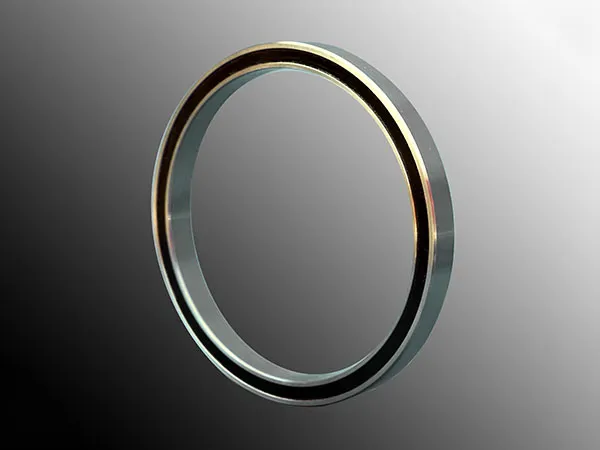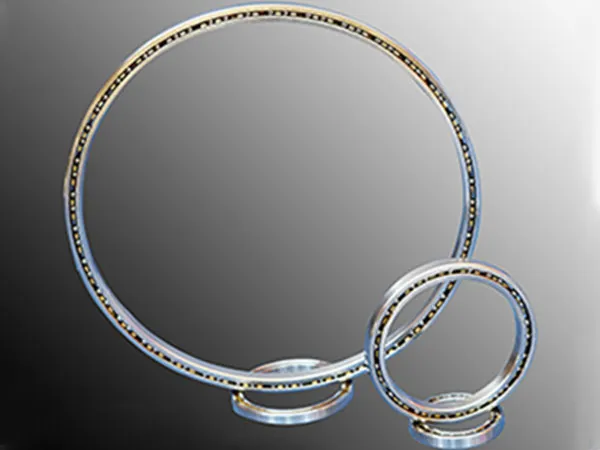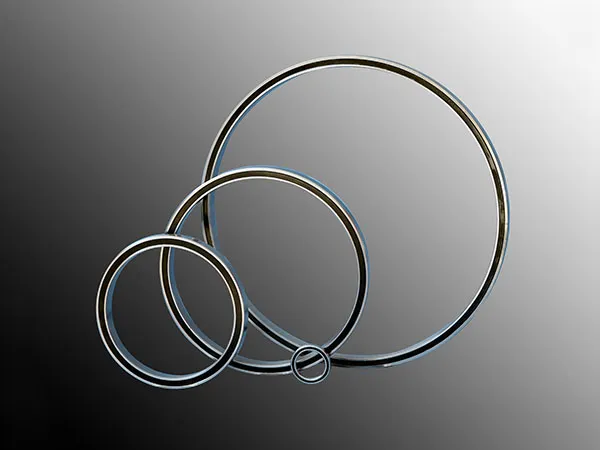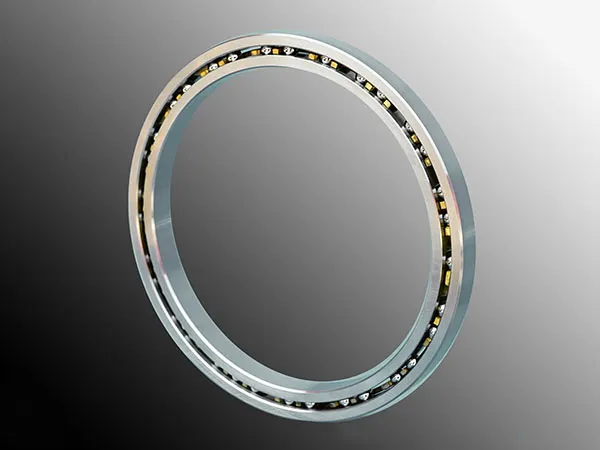Reducing noise in thin section bearings involves addressing potential sources at various stages: bearing selection, installation, lubrication, and operation. Thin section bearings are particularly sensitive due to their high diameter-to-cross-section ratio, making them more flexible and susceptible to distortion.

Higher Precision Grade: Choose bearings with higher ABEC (Annular Bearing Engineers' Committee) or ISO (International Organization for Standardization) precision classes. Higher precision means tighter tolerances on raceway geometry, ball sphericity, and surface finish, leading to smoother operation.
Internal Clearance: Select the appropriate internal clearance (C2, C0, C3, etc.). Too much clearance can lead to ball skidding and noise, while too little (or excessive preload) can increase friction, heat, and noise. The correct clearance depends on the application, fit, and operating temperature.
Cage (Retainer) Material & Design:
Polymer Cages: Nylon (polyamide) or PEEK cages can dampen vibrations and run quieter than steel cages, especially at high speeds.
Crown-type or Snap-over Cages: These can sometimes be quieter than ribbon-type cages.
Full Complement (No Cage): While offering higher load capacity, these are generally noisier due to ball-to-ball contact.
Ball Material: Ceramic balls (e.g., Silicon Nitride, Si3N4) are lighter, harder, and smoother than steel balls. This reduces centrifugal forces, wear, friction, and can lead to quieter operation.
Seals and Shields: While primarily for keeping contaminants out and lubricant in, they can offer a slight damping effect. However, rubbing seals can also be a source of noise if not properly designed or lubricated.

Housing and Shaft Geometry:
Roundness & Cylindricity: Thin section bearings conform to the shape of the shaft and housing. Any out-of-roundness or taper in the mating components will distort the bearing rings, leading to uneven load distribution, increased stress, and noise. Use high-precision machining for mating surfaces.
Concentricity & Perpendicularity: Ensure shaft and housing bores are concentric and shoulders are perpendicular to the axis. Misalignment is a major noise contributor.
Surface Finish: Mating surfaces on the shaft and housing should be smooth (low Ra value) to ensure good contact and prevent fretting.
Correct Fits: Interference fits can distort thin rings if too tight. Clearance fits can allow the bearing to creep or pound. Follow manufacturer recommendations meticulously. Sometimes, adhesive bonding is used for uniform support.
Uniform Preload: If preload is required (common in precision applications), apply it uniformly. Uneven preload distorts the bearing. Springs (e.g., wave springs, Belleville washers) can provide a more consistent preload than rigid clamping.
Cleanliness: Contamination (dirt, debris, machining chips) is a primary cause of bearing noise and premature failure. Ensure extreme cleanliness during assembly.
Mounting Tools & Technique: Use proper tools (e.g., bearing heaters, arbor presses with appropriate fixtures) to avoid damaging or distorting the bearing during installation. Apply force only to the ring being fitted.

Correct Lubricant Type:
Grease: Generally preferred for noise damping. Choose a grease with appropriate base oil viscosity, thickener type, and additives. Some greases are specifically formulated for low noise.
Oil: Can be used, but may require more sophisticated sealing and delivery systems. Low viscosity oils can sometimes lead to more noise if the EHL film is insufficient.
Correct Lubricant Quantity:
Too little: Leads to metal-to-metal contact, wear, and noise.
Too much (grease): Can cause churning, increased operating temperature, lubricant degradation, and noise. Typically, fill 20-40% of the bearing's free space.
Lubricant Cleanliness: Use clean, filtered lubricant. Contaminated lubricant will act as an abrasive.
Relubrication: If applicable, follow recommended intervals and procedures. Over-lubrication or mixing incompatible greases can be problematic.
Speed and Load: Operate within the bearing's design limits. Excessive speeds can cause ball skidding, especially under light loads. Excessive loads can cause plastic deformation.
Vibration Damping: Isolate the bearing from external vibrations. Consider using damping materials in the housing or supporting structure.
Temperature Control: Excessive temperatures can degrade lubricant and alter clearances, leading to noise.
Resonance Avoidance: Ensure that the natural frequencies of the system (shaft, housing, support structure) do not coincide with the bearing's operating frequencies (e.g., ball pass frequencies). This can amplify bearing noise.
Structural Stiffness: A stiffer housing and shaft can reduce deflections and vibrations that contribute to noise.
Acoustic Enclosures: If noise is still an issue and cannot be reduced at the source, consider an acoustic enclosure around the equipment.

If noise develops in an existing application:
Check for Contamination: Inspect lubricant for particles.
Inspect for Damage: Look for brinelling, spalling, fretting corrosion, or wear.
Verify Lubrication: Is it sufficient, correct type, not degraded?
Measure Mounts: Check shaft/housing for out-of-roundness or damage.
Check Alignment & Preload: Ensure they are still within specification.
By systematically addressing these points, particularly focusing on the precision of mating components and careful installation for thin section bearings, you can significantly reduce operational noise.
Customized Precision Crossed Roller Bearings: Unlocking Maximum Industrial Performance
2025-11-24 10:45How to Minimize Vibration in Precision Crossed Roller Bearings for Maximum Efficiency
2025-11-19 11:19Top 6 Maintenance Tips for Precision Crossed Roller Bearings to Maximize Lifespan and Accuracy
2025-11-15 13:46Step-by-Step Guide: How to Install Precision Crossed Roller Bearings for Maximum Performance
2025-11-09 00:24Address: Lianmeng Road, Jianxi district, Luoyang City,Henan province.
E-mail: info@lynicebearing.com
Phone: +86-379-60689957
If you are interested in our products and services,
please feel free to contact us!
Get in tuch

+86-379-60689957
Lianmeng Road, Jianxi district, Luoyang City,Henan province.